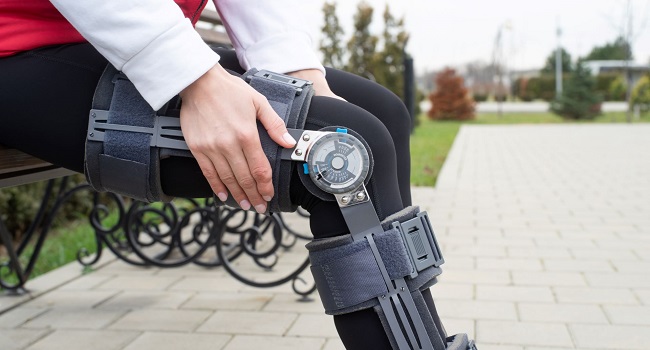In orthotic care, technological advancements are perpetually ushering in new ways to improve mobility and enhance the quality of life for patients with walking impairments. One of the most groundbreaking innovations is the C-Brace.
Unlike traditional braces with limited dynamic control, the C-Brace deploys advanced sensor technology and real-time gait analysis to adapt to different walking speeds, terrains, and movements. Doing so shifts the paradigm from mere support to integrated, adaptive care that understands each individual’s unique biomechanical needs.
How Does C-Brace Work?
The C-Brace employs a system that uses sensors and microprocessors to understand the user’s movements and intentions.
These sensors continuously monitor parameters like speed, angle, and force, adjusting the hydraulic resistances at the knee and ankle joints in real time. This provides unparalleled support and freedom during various activities, such as walking, climbing stairs, or even standing.
Its ability to adapt to different terrains and walking speeds sets the C-Brace apart. Whether navigating through rocky trails or strolling on flat surfaces, the brace’s intuitive system adjusts accordingly to offer the optimum level of support. This eliminates the “robotic” feel that comes with traditional braces, which often inhibit natural movement.
Traditional braces are primarily passive, providing stability but not adapting to changes in movement or activity level. In contrast, the C-Brace is a dynamic system that actively assists the user during their various phases of gait, making it a transformative tool in lower limb orthotics.
Advantages Over Traditional Braces
The transformative impact of the C-Brace goes beyond its technological prowess; it offers a host of advantages that significantly improve the quality of life for individuals with mobility challenges. Here is a detailed look at how the C-Brace is redefining orthotic care.
-
Dynamic, Real-Time Adaptability
Due to its sensor-driven, microprocessor-controlled system, the C-Brace is designed to adapt to various activities and terrains in real time. This adaptability allows for a more natural walking experience, unlike traditional braces, which can be restrictive and inflexible. Whether walking flat surfaces or climbing stairs, the device adjusts its hydraulic resistance at the knee and ankle joints to provide optimal support.
-
Enhanced Comfort
Traditional braces often come with discomfort due to their rigid structure and lack of adaptability. The C-Brace, on the other hand, is ergonomically designed to minimize discomfort and facilitate more extended use. Its real-time adaptability also makes it comfortable to wear in various scenarios.
-
Long-Term Rehabilitation
One of the most significant advantages of C-Brace is its potential for aiding in long-term rehabilitation. The brace encourages natural movement patterns, which can contribute to muscle strengthening and overall biomechanical improvement over time. This is particularly beneficial for those recovering from injuries or surgeries.
-
Psychological Benefits
The sleek design and dynamic adaptability of the C-Brace can significantly improve the user’s self-esteem and social comfort. Traditional braces are often noticeable and attract attention to the wearer’s condition, whereas the C-Brace is less conspicuous. Moving more naturally can also boost the wearer’s confidence, promoting greater social interaction and an improved quality of life.
-
Broad Spectrum Of Users
The C-Brace can be used by a diverse range of individuals, from those recovering from traumatic injuries to those with degenerative conditions affecting their lower limbs. Its adaptability and customizability make it suitable even for people who engage in sports or outdoor activities. This opens up the possibility for a more active lifestyle for many who were previously limited by their conditions.
-
Customizability Through Software
The C-Brace may come with an associated smartphone app for further customization. Medical professionals can calibrate the brace to meet individual needs or to be optimized for specific activities. This personalized approach enhances both the comfort and effectiveness of the orthotic solution.
-
Integration With Future Technologies
The C-Brace is already on the cutting edge of orthotic technology and is positioned to integrate seamlessly with future advancements. Whether it’s more advanced sensors, health monitoring systems, or machine learning algorithms, the C-Brace is built with a view toward future compatibility. This makes it a long-term investment in the user’s health and mobility.
By offering these diverse advantages, the C-Brace provides immediate benefits and opens doors to a more active, comfortable, and fulfilling life for individuals facing mobility challenges.

Cost And Accessibility
Although the C-Brace is revolutionary, its higher cost than traditional braces can be a barrier for some. However, it’s essential to consider the long-term benefits and cost-effectiveness of this advanced orthotic system.
The upfront investment in a C-Brace could mean fewer medical bills in the future related to strain injuries or falls. Its dynamic adaptability could also potentially increase occupational opportunities for users, thereby improving financial stability in the long term.
Various financing options, insurance coverage, and grants may be available to assist with the cost, making it more accessible for a wider range of patients. The goal is to ensure this groundbreaking technology can benefit as many people as possible.
Conclusion
The C-Brace represents a paradigm shift in the field of lower limb orthotics. Its dynamic adaptability offers unparalleled freedom and safety, enabling wearers to navigate multiple terrains, reduce physical strain, and participate more fully in social activities.
While the initial cost may be higher, the long-term benefits it offers, both physically and emotionally, make it a revolutionary tool in orthotic care.
















